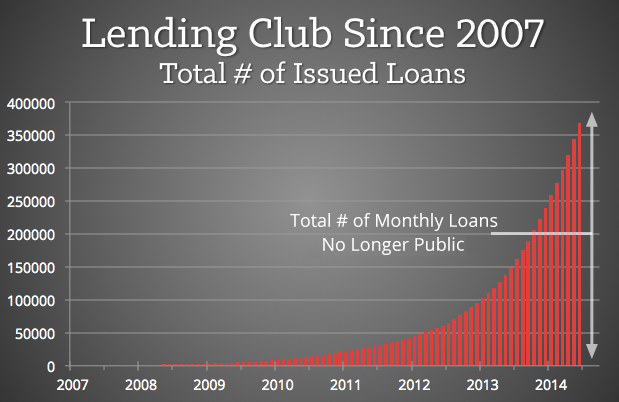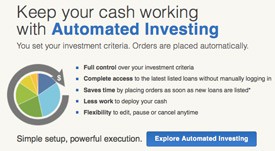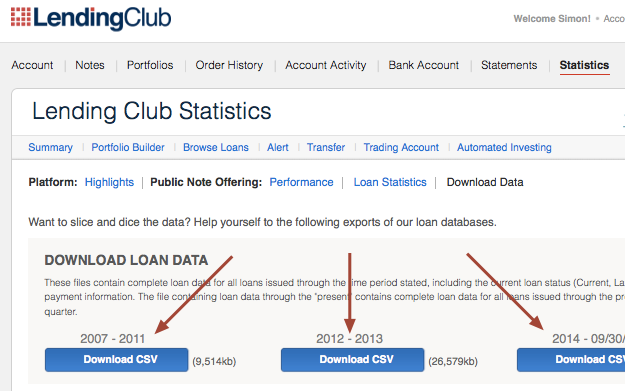With their IPO right around the corner, much has been happening at Lending Club. Yesterday they released this great statistics page, and today a scrap of gossip broke that Lending Club may be seeking a buyer (Reuters), which could mean huge changes for the months ahead. Also, their numbers for Q3 were released showing them issuing another record-breaking quarter of $1.146 $1.165 billion in new loans.
Lending Club removed half of the borrower variables from the open data.
All of this, however, is second to a more difficult piece of news from last Thursday. Starting with an announcement to their API users, and followed up by an edit of their downloadable .CSV file, Lending Club removed a significant amount of the loan data they make available to their investors. You can read the full list here, but the short story is that Lending Club removed half of the borrower variables from the open data, as well as all of the data on the ‘Policy 2’ loans that comprise 25% of their total issuance.
This change came without any warning at all, and was a huge shock to many within the industry. Indeed, Lending Club has still not communicated to investors the reasons for this weighty act. Some of the biggest names in peer to peer lending had built up complex algorithms around this data, so they sort of felt like the rug had been pulled out from under them. That said, these savvy institutions comprise only a small portion of Lending Club’s overall investors.
A much larger group affected by this change is the investor community as a whole. This is because halving the open data, if permanent, represents a fundamental shift within peer to peer lending as we know it.
Lending Club, the Anti-Bank
The big issue here is Lending Club’s transparency. For most of its history, this company has provided data on every loan they’ve ever issued. The high water mark of this policy was actually in 2012 when they voluntarily increased their borrower variables from 56 to 100. But ever since then it has been a steady movement in the other direction.
The reason why they opened up this data in the first place was to be honest with the public about how they were doing as a company. This is because Lending Club sees itself as a sort of ‘anti-bank’. Their company stands as a new, smarter, more human and crowdfunded face of American finance, and being transparent with its data is in line with that value.
“We want to transform the banking system into a marketplace that is more competitive, more consumer-friendly, more transparent.”
CEO Renaud Laplanche, Fortune.com March 2014
This posture has been incredibly refreshing for investors, considering the big banks have historically been some of the country’s most opaque and fickle institutions. Here is Bear Stearns CEO James Cayne talking before a federal commission about his company’s role in the the 2008 crisis (Wall Street Journal):
“Bear Stearns’ collapse was not the result of any actions or decisions unique to Bear Stearns. Instead, it was due to overwhelming market forces that Bear Stearns, as the smallest of the independent investment banks, could not resist.”
Mr. Cayne’s statement is abjectly untrue. Investing in sub-prime debt the way he did (alongside many others) may have been a decent gamble at the time, but it eventually resulted in the worst economic meltdown since the Great Depression. Five percent of the country (~15 million people) indirectly lost their jobs and many more suffered great distress because of the actions of bankers like himself.
So for peer to peer companies like Lending Club, the bank’s hubris in 2008 gives them a distinct opportunity to be different. As a result, Lending Club has consistently worked to keep investors acutely aware of the quality and performance of their loans, and they did this by releasing the raw data to the public.
If you were worried that Lending Club was approving low-quality borrowers, all you had to do was download the loans via a .CSV file on their statistics page, and open it using Microsoft Excel. It would show that the average credit score of their borrowers is around 700, the standard for prime-rated loans. If you were worried that the loans were actually junk despite the credit scores, you could simply download this same file to examine the loan performance year over year (default rates are 5%).
All of this to say, for Lending Club to suddenly remove significant sections of their open data marks a shift in its founding identity. Indeed, one could argue that a peer to peer lending platform without any open data whatsoever garners no more public trust than a big bank. The only difference would be its lack of brick and mortar. For example, is Amazon.com really any friendlier than the Wal-Mart it replaced? Not really (Forbes).
P2P Lending’s Rich History of Collaboration
The reality is that this rich open data has set peer to peer lending distinctly apart from finance as usual. It is what inspired its most passionate proponents to get involved. For example, here is Orchard co-founder David Snitkof recounted the very genesis of his company in a recent blog post:
“Fascinated by the open availability of information, the more analytically enterprising among us began to experiment with the data in our free time.”
David’s testimony is quite common within this space. Most retail investing websites (NSR, BluVestment, PSL, etc.) are run by people with jobs outside the industry, by proponents donating their free time. All this to say, Lending Club’s open data is intrinsically inspiring in nature, responsible for some of the richest investor collaboration on the web today. Here are three categories:
#1. Independent investor tools
 The first and most powerful instance of this collaboration is seen in software developers creating online statistical tools that compile and slice up the data in all sorts of interesting ways. The earliest site was the now-defunct LendStats tool by Ken. Michael then created NickelSteamroller (NSR) in 2011, which took the LendStats tool and greatly improved upon it. The early NSR tool did not have data for Prosper though, so another developer (Rocco) created Prosper-Stats in 2012. Michael and Rocco then partnered up in 2013 under the banner of NSR to become the most useful peer to peer lending statistics site nationwide.
The first and most powerful instance of this collaboration is seen in software developers creating online statistical tools that compile and slice up the data in all sorts of interesting ways. The earliest site was the now-defunct LendStats tool by Ken. Michael then created NickelSteamroller (NSR) in 2011, which took the LendStats tool and greatly improved upon it. The early NSR tool did not have data for Prosper though, so another developer (Rocco) created Prosper-Stats in 2012. Michael and Rocco then partnered up in 2013 under the banner of NSR to become the most useful peer to peer lending statistics site nationwide.
And here’s the amazing thing: all of these tool sites are completely free, written in the spare time of generous and talented investors. Ken, Michael, and Rocco never launched their tools with a ‘Premium’ feature. Still today, they give countless hours of work away to the public without any strings attached.
This demonstrates the gift that the open data has been for the wider investor community, a generosity that investors can’t help but respond to by being generous in return.
#2. Independent credit models
 A second huge advantage of the open data has been the ability for freelance investors to create independent credit models/algorithms. Some have used these models for private investing, but others have used them as a service for the wider investor community. For example, Bryce Mason first announced his credit model here (Lend Academy), and then integrated it on a simple website (P2P-Picks) for small-dollar retail to use for investing on Lending Club’s platform. Similar to NSR, he never really charged for using his tool.
A second huge advantage of the open data has been the ability for freelance investors to create independent credit models/algorithms. Some have used these models for private investing, but others have used them as a service for the wider investor community. For example, Bryce Mason first announced his credit model here (Lend Academy), and then integrated it on a simple website (P2P-Picks) for small-dollar retail to use for investing on Lending Club’s platform. Similar to NSR, he never really charged for using his tool.
Was the main purpose of his credit model to game Lending Club’s loans for higher returns? Perhaps initially, but it soon became apparent that simply increasing ROI was not a secondary credit model’s best feature.
“I have come to view the main purpose of independent modeling to be protective, guarding against a situation where originators grade their own loans and where these definitions may vary over time or even suddenly change or degrade. There may still be some opportunity to outperform an index, but it is modest and secondary to the protective element.”
Bryce Mason, P2P-Picks
As Bryce points out, the open data has given investors the ability to scrutinize the quality of the loans for themselves, and by extension, to independently assert Lending Club’s quality in the public square.
#3. Independent media
Similarly, this space has been filled with investors writing about the industry and sharing their returns, such as Peter Renton’s Lend Academy and Ryan Lichtenwald’s PeerSocialLending. This coverage is incredibly unique for a debt issuer. No where on the internet do you have someone pouring time into a website about Discover Loans, talking about Discover’s metrics and innovation, analyzing SEC filings, etc.

2012 site logo
This is where LendingMemo fits in. I began working on this site in late 2012 completely out of fascination with Lending Club. Revenue was never why this site was launched, nor has it ever been the major driver behind the hours I poured into it in the years that followed. Much more, I was profoundly inspired by what Lending Club was doing and wanted others to get involved as well.
The driver behind all of this collaboration is Lending Club’s transparency. Like David Snitkof’s quote above, the open data is what makes this whole thing shine. Statistics sites like NSR shape the raw datasheets into digestible chunks, and media sites like mine take those chunks and communicate them in a way the public can hear.
In short, the reason LendingMemo is filled with interesting and useful content is because I love peer to peer lending, and this passion is largely the result of Lending Club’s open data.
Lost Transparency Means a Disempowered User Base
Thursday’s change marked a sad decline in that generous data, and with it, real doubt about the investor community’s ability to collaborate alongside Lending Club in the years to come. This is because thinning the data hinders generous statistics sites like NickelSteamroller to independently allow investors to break down the historically issued loans by credit variables, an option that has been responsible for much of the trust around this new investment.
Armed with 56 credit variables instead of 100, generous statisticians like Bryce Mason are less able to stand apart from Lending Club and use an independent algorithm to proclaim that, yes, Lending Club is still issuing a quality product.
The new changes deeply affect sites like LendingMemo as well:

When an interested person starts researching Lending Club in a search engine, they eventually find investor-run sites like Lend Academy or LendingMemo, and soon enough they see growth charts like what you see above – charts that have convinced many of them to get on board.
But the reduced data changes all that. For example, Policy 2 loans have now been completely removed, so sites like mine have no ability to chart the overall metric of Lending Club’s growth. Set aside for private institutional investors, Policy 2s comprise 25% of the issued loans. As sites like LendingMemo and Lend Academy are working to assure investors that Lending Club is doing well as a company (and talk down bankruptcy worries), we now have zero insight into 25% of the work they do, a percentage that climbs higher each quarter.
How to Make History: Imagining Open-Sourced Finance
As Lending Club primes itself for its coming IPO, and as they discuss internally how much data should be released to the public in the years going forward, I would like to make a case that keeping their loan data completely open to the public means huge dividends for the years to come. The fact is that Lending Club is this industry’s leader, so the precedent they set today will inform best-practices for everybody else.
Three invaluable reasons to remain transparent:
#1. Public trust: a rich available dataset allows investors, both new and existing, to explore Lending Club’s overall performance from external non-biased websites, and subsequently to feel good about this investment. This alone is reason enough. Statistics hosted at LendingClub.com will likely never carry the same weight.
 #2. Rapid innovation: open data allows 3rd parties to spring up and fill in functionality where this investment is lacking. These sites can then inform Lending Club about ways it can improve. For example, 3rd party sites like Interest Radar offered automated investing long before Lending Club did themselves. They then added this functionality, and most new investors today auto-invest onsite. Additional creative 3rd party tools will eventually spring up around other unaddressed functionality in the coming years. Rinse and repeat. Everybody wins.
#2. Rapid innovation: open data allows 3rd parties to spring up and fill in functionality where this investment is lacking. These sites can then inform Lending Club about ways it can improve. For example, 3rd party sites like Interest Radar offered automated investing long before Lending Club did themselves. They then added this functionality, and most new investors today auto-invest onsite. Additional creative 3rd party tools will eventually spring up around other unaddressed functionality in the coming years. Rinse and repeat. Everybody wins.
#3. Passionate publicity: being generous with their data naturally fosters an empowered community of interested people who can independently proclaim Lending Club’s success. No marketing budget in the world can compare to a passionate user base that feels ownership over a product they love and share with others. IE: Android (one billion users).
What could this look like? My idea for a way forward.
I’ve spoken off the record with people close to Lending Club who speculate the reasons for cutting the open data, one of which was a desire for Lending Club to level the investor playing field. Algorithm-enabled institutions vacuum up the best loans, which means everybody else’s returns go down, so I agree that the playing field is uneven. That said, I also think there is an easier fix than just slashing all the data by half.
A solution: decrease the variables in the Browse-Notes data so we can increase the variables in the Issued-Loans data. If Lending Club wants to stop savvy institutions from vacuuming up the top 10% of the loans, I suggest they remove 90% of the variables for loans still getting funding. Most investors filter with less than 5 variables anyways, so almost nobody would be impacted. With this problem solved, Lending Club could return their issued loan data back to where it was. If the tradeoff is transparency versus marginally increased returns, we should all be on the side of transparency.
The Opportunity for a Thriving Ecosystem
In summary, I would like to believe last Thursday was a small hiccup in an otherwise exciting time in American finance. Ideally, Lending Club will move into their IPO with a commitment to upholding the value of its open data for the years to come.
We are only just beginning to witness an empowered Lending Club ecosystem.
We have to remember that, similar to the industry as a whole, we are only just beginning to witness what an empowered Lending Club ecosystem looks like. This is a company that has grown at more than 100% per year, so the full richness of an active investor community has yet to be seen.
The fact of the matter is that no retail investor tools have been able to hit profitability, and this is largely because Lending Club’s investor base remains small, at least relative to the national population. As this industry grows, and its retail community grows large enough to support even more powerful 3rd party tools, Lending Club will reap the rewards of a collaborating user base. Indeed, the most valuable company in the world is Apple, a company with an ecosystem that offers one million 3rd party apps to anyone who owns one of their computers.
As Lending Club’s IPO thrusts our industry into the national spotlight, and as its investor base grows and expands in the years to come, we have an opportunity to witness the birth of one of the most creative and smart ecosystems that American finance has ever seen. The only thing that could hamstring this vision is a disempowered investor base. In this way, Lending Club stands today at a crossroads.


Very well written Simon, and I believe quite representative of a healthy portion of the feelings and reactions that folks have had over the last week. Unfortunately, I am not buying the investor parity moves. As you’ve said, most investors use but a fraction of the available criteria, so eliminating most of them does little to ensure the “best” loans won’t get snapped up. If investor parity was the real concern, there are a myriad of ways to address those concerns, and this wasn’t one of the more obvious means of doing so.
To me, the two biggest indicators that speak to a different motive than investor parity is the lack of communication regarding these changes and the removal of complete transparency into the other side of their business, the policy code 2 loans. Perhaps it is due to their pre-IPO timing that communication isn’t more forthcoming, but certainly such period of time shouldn’t prevent a token level of communication and reasoning behind such a material change to the way investors, and the greater community at large, interact and invest.
During some of the discussion on Lend Academy in the last quarter after the rocky Q2 loan results, I ran some numbers on the historic policy code 2 loans, and the level of growth in the past 15 months attributable to those loans is unbelievable. When, at the end of this past June, almost a third of all loans issued were compromised of policy code 2 loans, it showed a tremendous strategy shift in operations with limited transparency.
Ultimately, like yourself and others, I’m disappointed in Lending Club’s handling of this. Understanding why they’ve decided this is much less important than to examine what this means for my, and other investors, future relationship with Lending Club. As with any relationship build on trust and transparency, a material violation can forever affect the longevity of the relationship.
Great thoughts Adam. Like you pointed out, Lending Club’s quiet period is probably adding to the lack of communication around this issue.
I agree 100%. The transparency and data is what got me interested in the industry. I loved the fact that Lending Club let me decide where to put my money based upon the data. Let users decide what tools to make with the data. And shared information about the growth of the company.
I keep holding out hope that maybe these changes are just related to the IPO and quite period. We won’t know for sure until after the IPO, but I’m getting the sense that they are actually changes in company culture and strategy.
Yes, Lending Club has removed 50% of the data, yes they failed to provide a proper explanation, and yes Policy 2 loans are growing fast.
But
1) Machine-learning analysis shows the dropped data were not statistically significant (meaning they were of little use or that other, more useful covariates contain the signal)
2) Nothing proves an evil intention. Let’s not forget the success of Peer Lending today owes an awful lot to Lending Club, I personally doubt its management has sold out.
1. Thanks Emmanuel. Having spoken with Bryce and others, as I mentioned above, I do believe the dropped data would have been of significant interest in figuring out the quality of the loans independently using a secondary credit model. You’re right that the most useful variables are still here, which is a relief.
2. I hope the article doesn’t communicate ill will on behalf of the Lending Club management. I certainly don’t feel any. What I do feel is a consistent backing off of data year by year, quarter by quarter, and what I hope they understand through pieces like this is the opportunity they stand to lose by depublicizing this data.
We owe a tremendous debt of gratitude to this company. Peer to peer lending wouldn’t be anywhere without them. And a huge part of caring about them is communicating how investors are feeling (in a non-entitled way).
Good luck – so long as the platform (a) makes a solid return for investors and (b) allows control over how you invest (IRA, manual, automated), then the company will roll on without much of a hitch. The most passionate fans, as far as I can tell, are on the platform first and foremost to make a return, and almost nothing is going to trump that in lieu of strong competition.
Thanks for your comment Jeff. However, I can attest that the high returns are not the sole driver behind the ecosystem, at least not for retail investors. It is equal parts returns and the open data that really make this investment both novel and exciting.
new to this site — and relatively new to P2P
Over the past few months as a new investor on LC, I have run into a growing list of issues for which there is no documentation. The customer support crew iterates with me to find detail on actual practices and thanks me for suggestions or for pointing out (what I believe to be) bugs. Other than that, I find little or no evidence that LC has an interest in the care and feeding of its investor community. I find this odd if the ongoing business model is really P2P as the investor community’s capital is going to have to grow to meet LC’s own growth projections.
It feels more like LC is going to be more comfortable in the future with institutional investors and their business will morph away from P2P.
I appreciate the content and tone of this web site
thanks
David